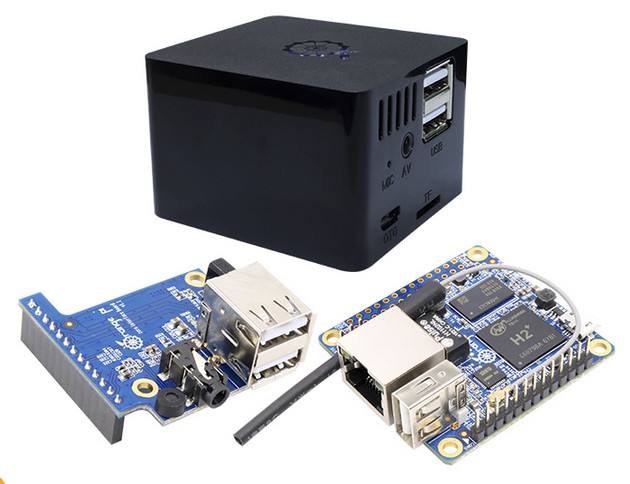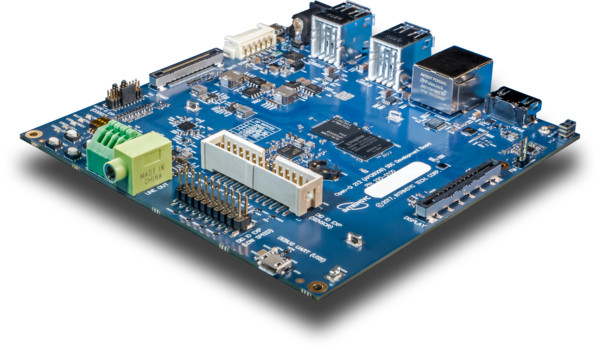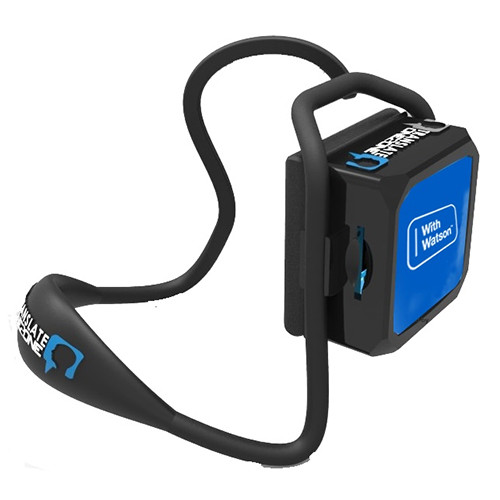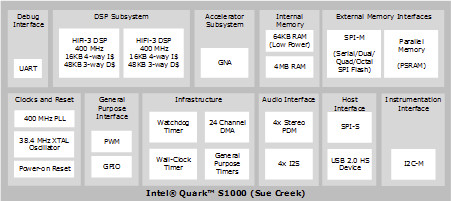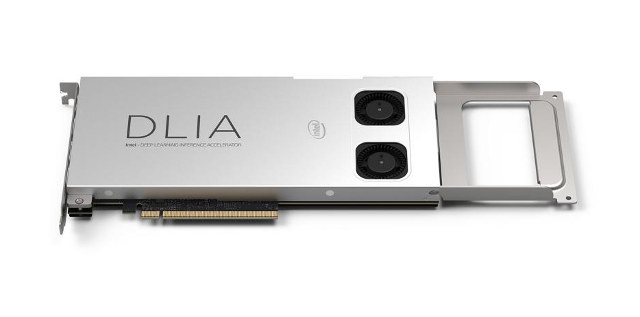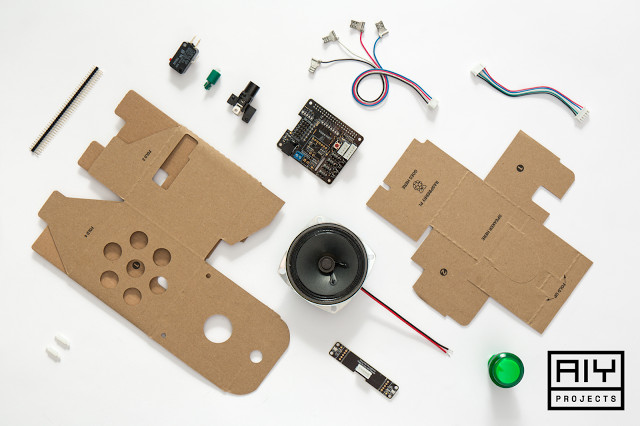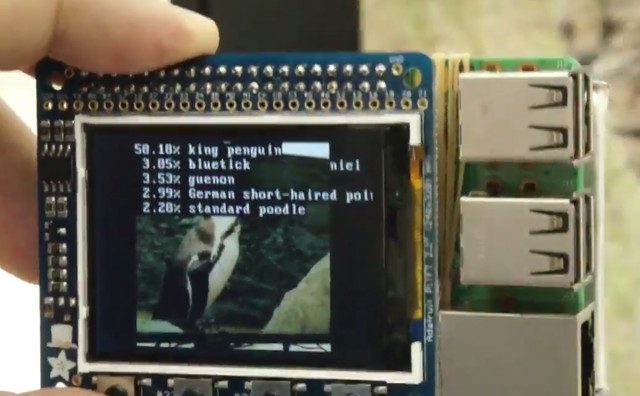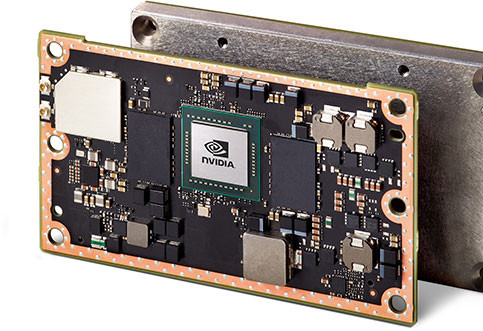Since Google released the Google Assistant SDK for Raspberry Pi 3, and other ARMv7 boards, I thought I should it try myself on one of the tiny headless boards I have, as you just need audio output and a microphone. I first planed to use NanoPi NEO board with NanoHAT PCM5102A audio board, a cheap USB microphone, and pair of speakers, but this morning, I’ve come across Orange Pi Zero Set 6 kit that looks perfect for this applications and sells for just $12.95 plus shipping ($18.27 in total for me) with Orange Pi Zero board, Orange Pi Zero interface board, and a case. Orange Pi Zero board is powered by Allwinner H2+ quad core Cortex A7 processor with 512MB RAM, and can run the required Ubuntu/Debian distribution using one of the Armbian images, and connected to the Internet over Ethernet or WiFi, however if you want to use the […]
Qualcomm Snapdragon 212 Boards – Intrinsyc Open-Q 212 and Kaynes Technology SKATE-212
Qualcomm Snapdragon 212 (APQ8009) quad core Cortex A7 processor is used in entry-level smartphones, but it’s also one of the processors which the company expects to use in their Smart Speaker Platform leveraging Google Assistant, Amazon Alexa, and other A.I. voice services. Two company has designed single board computers that can be used for this purpose: Intrisync Open-Q 212 and Kaynes Technology SKATE-212. Intrisync Open-Q 212 SBC Development Board Contrary to some other Open-Q boards, but not all, Open-Q 212 is not comprised of a baseboard and a system-on-module, as everything is soldered on a single PCB. Open-Q 212 specifications: SoC – Qualcomm Snapdragon 212 (APQ8009) quad core ARM Cortex A7 processor @ 1.267GHz with Adreno 304 GPU, QDSP6 DSP System Memory – 1GB LPDDR3 Storage – 8GB eMMC (non-POP) flash and micro SD card socket Connectivity – Ethernet, pre-scanned Wi-Fi 802.11n 2.4Ghz (WCN3610) with chip and U.FL antennas, Bluetooth 4.1 […]
Lingmo Translate One2One Earpiece Can Interpret 8 Languages with IBM Watson Natural Language & Translation APIs
Automation are greatly reduce the number of workers requires to perform manufacturing, and now technology is moving forward with artificial intelligence applications writing financial & sports news, analyzing medical imaging or other data to speed up and improve accuracy of diagnostics, and more. Yesterday, I found out that pair programming, which normally combines two human programmer working together on the same program, may soon pair a human programmer with an AI programmer helping selecting the best code, and today I found out live interpreters may get some competitions with products like Lingmo Translate One2One earpiece that can interpret 8 languages nearly in real-time. The device was unveiled at the United Nations Artificial Intelligence (AI) for Good Summit in Switzerland, as it combines IBM Watson’s Natural Language and Language Translation APIs, together with Lingmo’s proprietary hardware and machine learning applications. It’s said to be working as an independent device without the […]
Intel Quark S1000 “Sue Creek” Processor to Support On-Chip Speech Recognition
Intel may have announced plans to discontinue several of their IoT boards, but based on some documents I received, the company has not given up on the Quark family, although they may have given up on the Intel architecture for low power microprocessor, as Intel Quark S1000 – codenamed “Sue Creek” – will feature two Tensilica LX6 cores (yes, just like ESP32), and is designed to handle speech recognition at the edge (e.g. locally), so some of your voice commands should still work when Internet is down. Intel Quark S1000 key features and specifications: Digital Signal Processors Dual Tensilica LX6 cores @ 400 MHz with HiFi3 DSP Single precision scalar floating-point instructions 16KB 4-way I$; 48KB 4-way D$ Up to 2400 DMIPS, 3.2 GMACS (16×16), 800 MFLOPS of Compute Speech Accelerators A GMM (Gaussian Mixture Model) and neural network accelerator Low power keyboard and limited vocabulary recognition Up to 9.6 […]
Intel DLIA is a PCIe Card Powered by Aria 10 FPGA for Deep Learning Applications
Intel has just launched their DLIA (Deep Learning Inference Accelerator) PCIe card powered by Intel Aria 10 FPGA, aiming at accelerating CNN (convolutional neural network) workloads such as image recognition and more, and lowering power consumption. Some of Intel DLIA hardware specifications: FPGA – Intel (previously Altera) Aria 10 FPGA @ 275 MHz delivering up to 1.5 TFLOPS System Memory – 2 banks 4G 64-bit DDR4 PCIe – Gen3 x16 host interface; x8 electrical; x16 power & mechanical Form Factor – Full-length, full-height, single wide PCIe card Operating Temperature – 0 to 85 °C TDP – 50-75Watts hence the two cooling fans The card is supported in CentOS 7.2, and relies on Intel Caffe framework, Math Kernel library for Deep Neural Networks (MKL-DNN), and works with various network topologies (AlexNet, GoogleNet, CaffeNet, LeNet, VGG-16, SqueezeNet…). The FPGA is pre-programmed with Intel Deep Learning Accelerator IP (DLA IP). Intel DLIA can […]
AIY Projects Voice Kit Transforms Raspberry Pi 3 Into Google Home, Comes Free with Raspberry Pi Magazine
We’ve just reported about the preview release of Google Assistant SDK that works on the Raspberry Pi 3, and other boards with a microphone, speakers, and access to Internet. The Raspberry Pi foundation and Google have now made it even easier, as they launched AIY Projects Voice Kit with a Google Voice HAT, a speaker, a stereo microphone Voice HAT board, a button, a few cables, and a cardboard case. You’ll just need to add your own Raspberry Pi 3, follow the instructions to assemble kits, load and setup the software. Once this is all done, you’ll be able to press the top button, asking anything you want to Google Voice, including the weather. Price? Sort of free, as it comes with MagPi 57 magazine, where you’ll also find detailed instructions for the kit. Google AIY Projects got its name from a mix between (DIY) and artificial intelligence (AI), and […]
GPU Accelerated Object Recognition on Raspberry Pi 3 & Raspberry Pi Zero
You’ve probably already seen one or more object recognition demos, where a system equipped with a camera detects the type of object using deep learning algorithms either locally or in the cloud. It’s for example used in autonomous cars to detect pedestrian, pets, other cars and so on. Kochi Nakamura and his team have developed software based on GoogleNet deep neural network with a a 1000-class image classification model running on Raspberry Pi Zero and Raspberry Pi 3 and leveraging the VideoCore IV GPU found in Broadcom BCM283x processor in order to detect objects faster than with the CPU, more exactly about 3 times faster than using the four Cortex A53 cores in RPi 3. They just connected a battery, a display, and the official Raspberry Pi camera to the Raspberry Pi boards to be able to recognize various objects and animals. The first demo is with Raspberry Pi Zero. […]
NVIDIA Introduces Jetson TX2 Embedded Artificial Intelligence Computer
NVIDIA has just announced an upgrade to to their Jetson TX1 module, with Jetson TX2 “Embedded AI Computer” with Tegra X2 Parker SoC that either doubles the performance of its predecessor, or runs at more than twice the power efficiency, while drawing less than 7.5 watts of power. The company provided a comparison showing the differences between TX1 and TX2 modules. Jetson TX2 Jetson TX1 GPU NVIDIA Pascal, 256 CUDA cores NVIDIA Maxwell, 256 CUDA cores CPU HMP Dual Denver 2/2 MB L2 + Quad ARM® A57/2 MB L2 Quad ARM® A57/2 MB L2 Video 4K x 2K 60 Hz Encode (HEVC) 4K x 2K 60 Hz Decode (12-Bit Support) 4K x 2K 30 Hz Encode (HEVC) 4K x 2K 60 Hz Decode (10-Bit Support) Memory 8 GB 128 bit LPDDR4 58.3 GB/s 4 GB 64 bit LPDDR4 25.6 GB/s Display 2x DSI, 2x DP 1.2 / HDMI 2.0 / […]


